Interview Method: A Comprehensive Analysis of Selection Techniques
VerifiedAdded on 2022/12/14
|7
|1893
|267
Essay
AI Summary
This essay provides a comprehensive analysis of the interview method, a widely used technique in recruitment and selection processes. It begins by defining interviews and their role in predicting candidate job performance through oral responses. The essay then delves into the advantages of interviews, including increased accuracy in selection, resource efficiency, the ability to assess both verbal and non-verbal cues, interviewer control over the process, assessment of communication skills, and the flexibility in interview duration. The essay also highlights the high response rate associated with interviews and their ability to gauge candidate expectations. The discussion is supported by various sources, emphasizing the importance of interviews in making informed selection decisions and ensuring the recruitment of suitable candidates who contribute effectively to organizational goals. The essay also provides a bibliography of the cited sources.
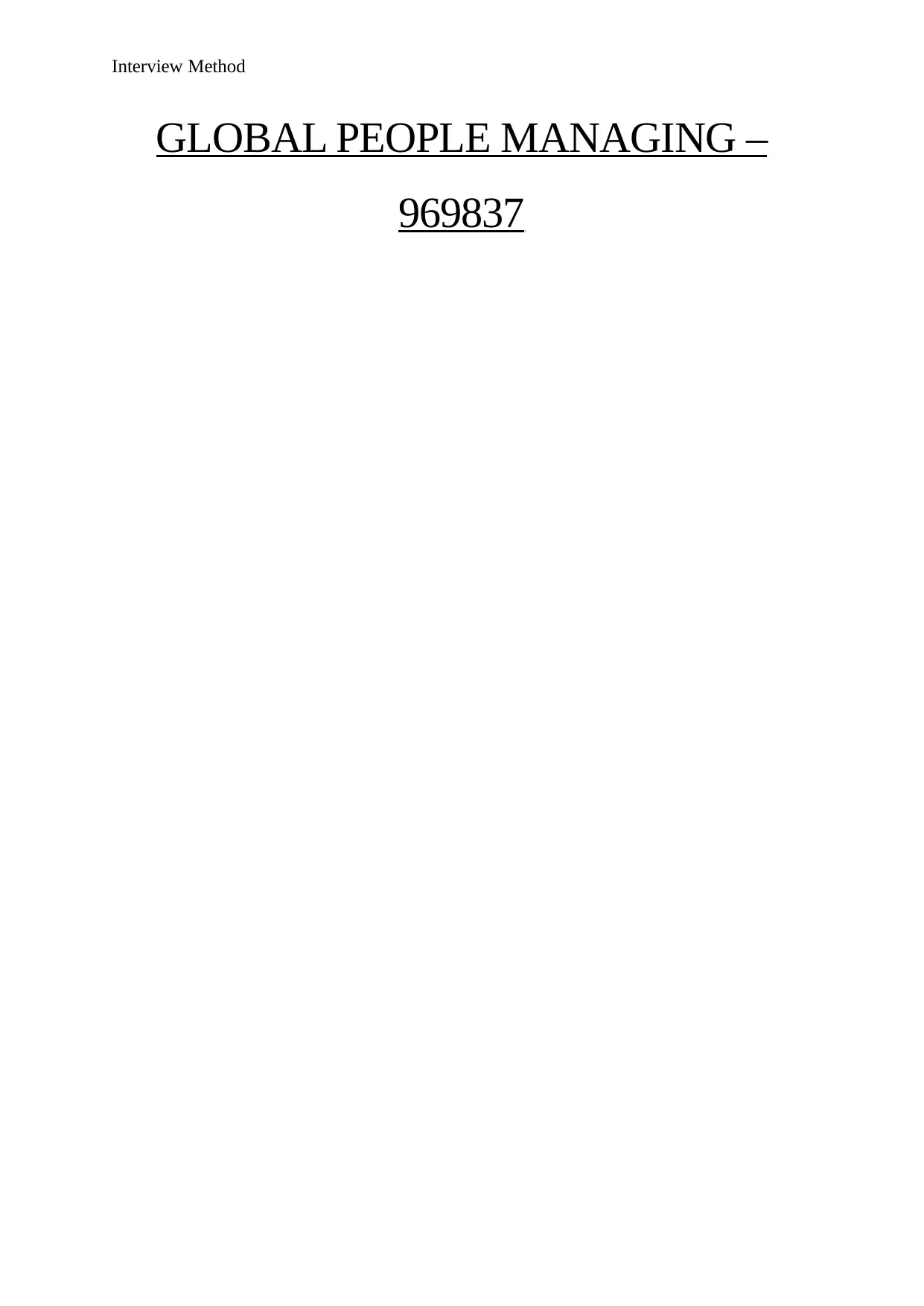
Interview Method
GLOBAL PEOPLE MANAGING –
969837
GLOBAL PEOPLE MANAGING –
969837
Paraphrase This Document
Need a fresh take? Get an instant paraphrase of this document with our AI Paraphraser
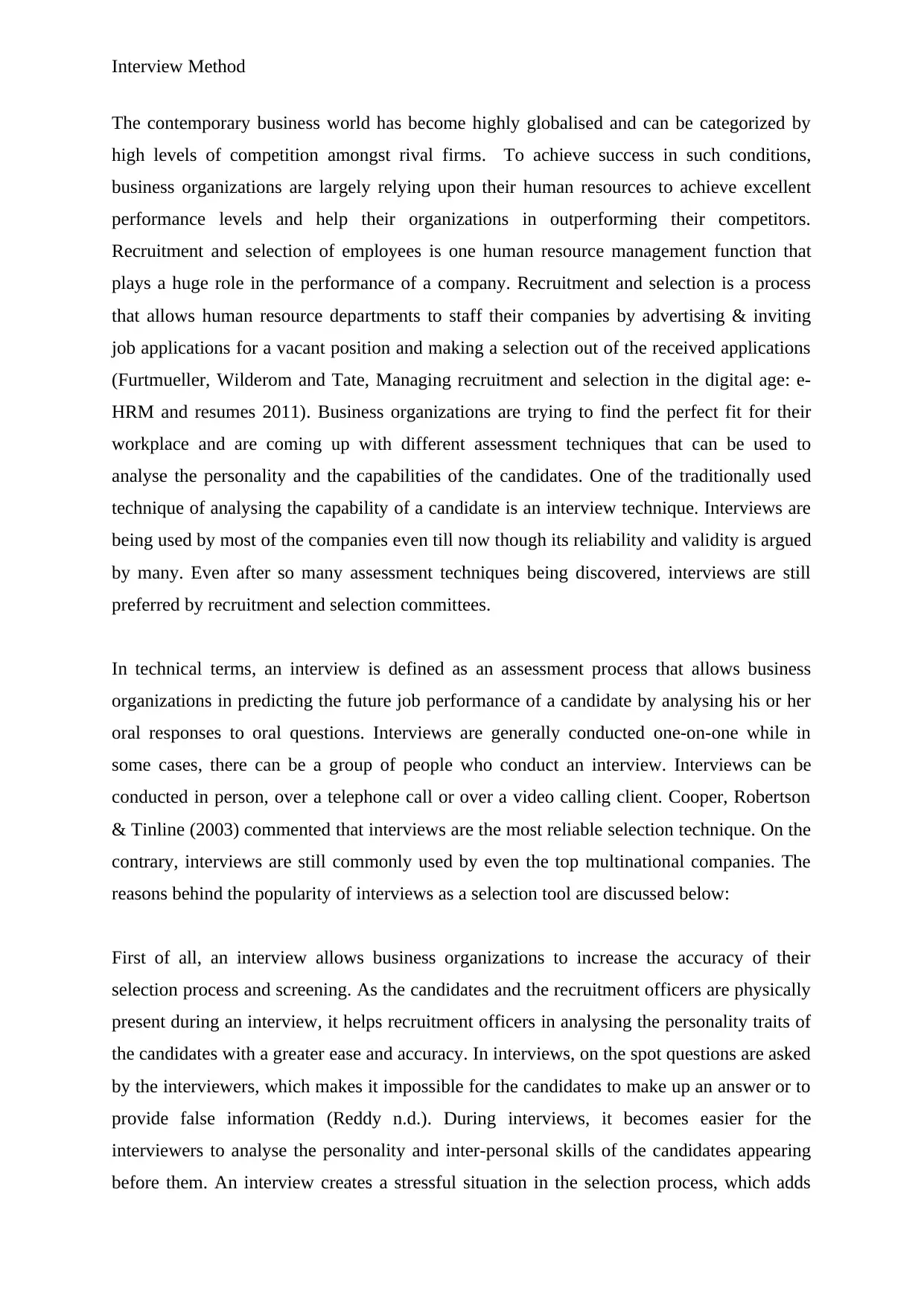
Interview Method
The contemporary business world has become highly globalised and can be categorized by
high levels of competition amongst rival firms. To achieve success in such conditions,
business organizations are largely relying upon their human resources to achieve excellent
performance levels and help their organizations in outperforming their competitors.
Recruitment and selection of employees is one human resource management function that
plays a huge role in the performance of a company. Recruitment and selection is a process
that allows human resource departments to staff their companies by advertising & inviting
job applications for a vacant position and making a selection out of the received applications
(Furtmueller, Wilderom and Tate, Managing recruitment and selection in the digital age: e-
HRM and resumes 2011). Business organizations are trying to find the perfect fit for their
workplace and are coming up with different assessment techniques that can be used to
analyse the personality and the capabilities of the candidates. One of the traditionally used
technique of analysing the capability of a candidate is an interview technique. Interviews are
being used by most of the companies even till now though its reliability and validity is argued
by many. Even after so many assessment techniques being discovered, interviews are still
preferred by recruitment and selection committees.
In technical terms, an interview is defined as an assessment process that allows business
organizations in predicting the future job performance of a candidate by analysing his or her
oral responses to oral questions. Interviews are generally conducted one-on-one while in
some cases, there can be a group of people who conduct an interview. Interviews can be
conducted in person, over a telephone call or over a video calling client. Cooper, Robertson
& Tinline (2003) commented that interviews are the most reliable selection technique. On the
contrary, interviews are still commonly used by even the top multinational companies. The
reasons behind the popularity of interviews as a selection tool are discussed below:
First of all, an interview allows business organizations to increase the accuracy of their
selection process and screening. As the candidates and the recruitment officers are physically
present during an interview, it helps recruitment officers in analysing the personality traits of
the candidates with a greater ease and accuracy. In interviews, on the spot questions are asked
by the interviewers, which makes it impossible for the candidates to make up an answer or to
provide false information (Reddy n.d.). During interviews, it becomes easier for the
interviewers to analyse the personality and inter-personal skills of the candidates appearing
before them. An interview creates a stressful situation in the selection process, which adds
The contemporary business world has become highly globalised and can be categorized by
high levels of competition amongst rival firms. To achieve success in such conditions,
business organizations are largely relying upon their human resources to achieve excellent
performance levels and help their organizations in outperforming their competitors.
Recruitment and selection of employees is one human resource management function that
plays a huge role in the performance of a company. Recruitment and selection is a process
that allows human resource departments to staff their companies by advertising & inviting
job applications for a vacant position and making a selection out of the received applications
(Furtmueller, Wilderom and Tate, Managing recruitment and selection in the digital age: e-
HRM and resumes 2011). Business organizations are trying to find the perfect fit for their
workplace and are coming up with different assessment techniques that can be used to
analyse the personality and the capabilities of the candidates. One of the traditionally used
technique of analysing the capability of a candidate is an interview technique. Interviews are
being used by most of the companies even till now though its reliability and validity is argued
by many. Even after so many assessment techniques being discovered, interviews are still
preferred by recruitment and selection committees.
In technical terms, an interview is defined as an assessment process that allows business
organizations in predicting the future job performance of a candidate by analysing his or her
oral responses to oral questions. Interviews are generally conducted one-on-one while in
some cases, there can be a group of people who conduct an interview. Interviews can be
conducted in person, over a telephone call or over a video calling client. Cooper, Robertson
& Tinline (2003) commented that interviews are the most reliable selection technique. On the
contrary, interviews are still commonly used by even the top multinational companies. The
reasons behind the popularity of interviews as a selection tool are discussed below:
First of all, an interview allows business organizations to increase the accuracy of their
selection process and screening. As the candidates and the recruitment officers are physically
present during an interview, it helps recruitment officers in analysing the personality traits of
the candidates with a greater ease and accuracy. In interviews, on the spot questions are asked
by the interviewers, which makes it impossible for the candidates to make up an answer or to
provide false information (Reddy n.d.). During interviews, it becomes easier for the
interviewers to analyse the personality and inter-personal skills of the candidates appearing
before them. An interview creates a stressful situation in the selection process, which adds
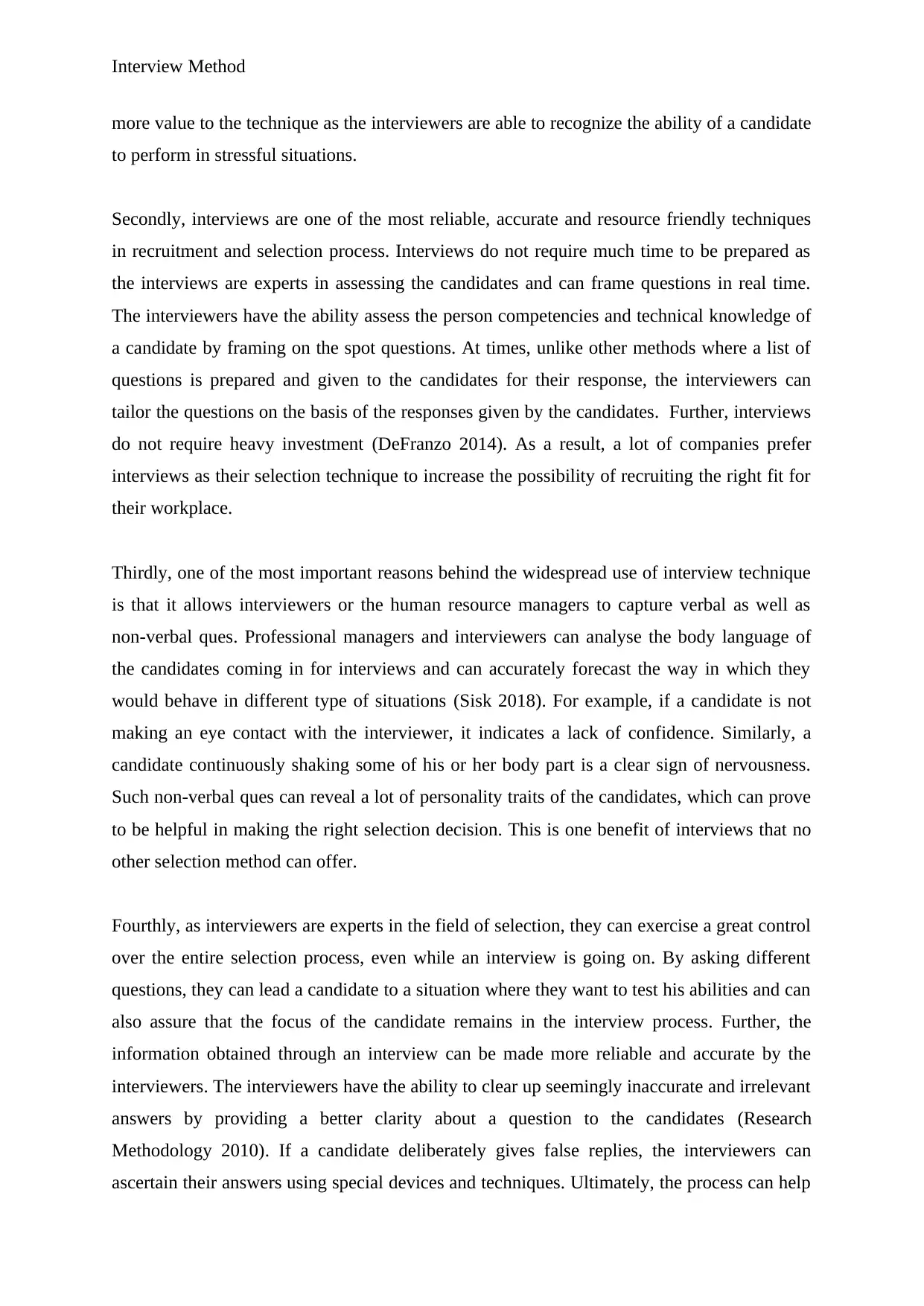
Interview Method
more value to the technique as the interviewers are able to recognize the ability of a candidate
to perform in stressful situations.
Secondly, interviews are one of the most reliable, accurate and resource friendly techniques
in recruitment and selection process. Interviews do not require much time to be prepared as
the interviews are experts in assessing the candidates and can frame questions in real time.
The interviewers have the ability assess the person competencies and technical knowledge of
a candidate by framing on the spot questions. At times, unlike other methods where a list of
questions is prepared and given to the candidates for their response, the interviewers can
tailor the questions on the basis of the responses given by the candidates. Further, interviews
do not require heavy investment (DeFranzo 2014). As a result, a lot of companies prefer
interviews as their selection technique to increase the possibility of recruiting the right fit for
their workplace.
Thirdly, one of the most important reasons behind the widespread use of interview technique
is that it allows interviewers or the human resource managers to capture verbal as well as
non-verbal ques. Professional managers and interviewers can analyse the body language of
the candidates coming in for interviews and can accurately forecast the way in which they
would behave in different type of situations (Sisk 2018). For example, if a candidate is not
making an eye contact with the interviewer, it indicates a lack of confidence. Similarly, a
candidate continuously shaking some of his or her body part is a clear sign of nervousness.
Such non-verbal ques can reveal a lot of personality traits of the candidates, which can prove
to be helpful in making the right selection decision. This is one benefit of interviews that no
other selection method can offer.
Fourthly, as interviewers are experts in the field of selection, they can exercise a great control
over the entire selection process, even while an interview is going on. By asking different
questions, they can lead a candidate to a situation where they want to test his abilities and can
also assure that the focus of the candidate remains in the interview process. Further, the
information obtained through an interview can be made more reliable and accurate by the
interviewers. The interviewers have the ability to clear up seemingly inaccurate and irrelevant
answers by providing a better clarity about a question to the candidates (Research
Methodology 2010). If a candidate deliberately gives false replies, the interviewers can
ascertain their answers using special devices and techniques. Ultimately, the process can help
more value to the technique as the interviewers are able to recognize the ability of a candidate
to perform in stressful situations.
Secondly, interviews are one of the most reliable, accurate and resource friendly techniques
in recruitment and selection process. Interviews do not require much time to be prepared as
the interviews are experts in assessing the candidates and can frame questions in real time.
The interviewers have the ability assess the person competencies and technical knowledge of
a candidate by framing on the spot questions. At times, unlike other methods where a list of
questions is prepared and given to the candidates for their response, the interviewers can
tailor the questions on the basis of the responses given by the candidates. Further, interviews
do not require heavy investment (DeFranzo 2014). As a result, a lot of companies prefer
interviews as their selection technique to increase the possibility of recruiting the right fit for
their workplace.
Thirdly, one of the most important reasons behind the widespread use of interview technique
is that it allows interviewers or the human resource managers to capture verbal as well as
non-verbal ques. Professional managers and interviewers can analyse the body language of
the candidates coming in for interviews and can accurately forecast the way in which they
would behave in different type of situations (Sisk 2018). For example, if a candidate is not
making an eye contact with the interviewer, it indicates a lack of confidence. Similarly, a
candidate continuously shaking some of his or her body part is a clear sign of nervousness.
Such non-verbal ques can reveal a lot of personality traits of the candidates, which can prove
to be helpful in making the right selection decision. This is one benefit of interviews that no
other selection method can offer.
Fourthly, as interviewers are experts in the field of selection, they can exercise a great control
over the entire selection process, even while an interview is going on. By asking different
questions, they can lead a candidate to a situation where they want to test his abilities and can
also assure that the focus of the candidate remains in the interview process. Further, the
information obtained through an interview can be made more reliable and accurate by the
interviewers. The interviewers have the ability to clear up seemingly inaccurate and irrelevant
answers by providing a better clarity about a question to the candidates (Research
Methodology 2010). If a candidate deliberately gives false replies, the interviewers can
ascertain their answers using special devices and techniques. Ultimately, the process can help
⊘ This is a preview!⊘
Do you want full access?
Subscribe today to unlock all pages.

Trusted by 1+ million students worldwide
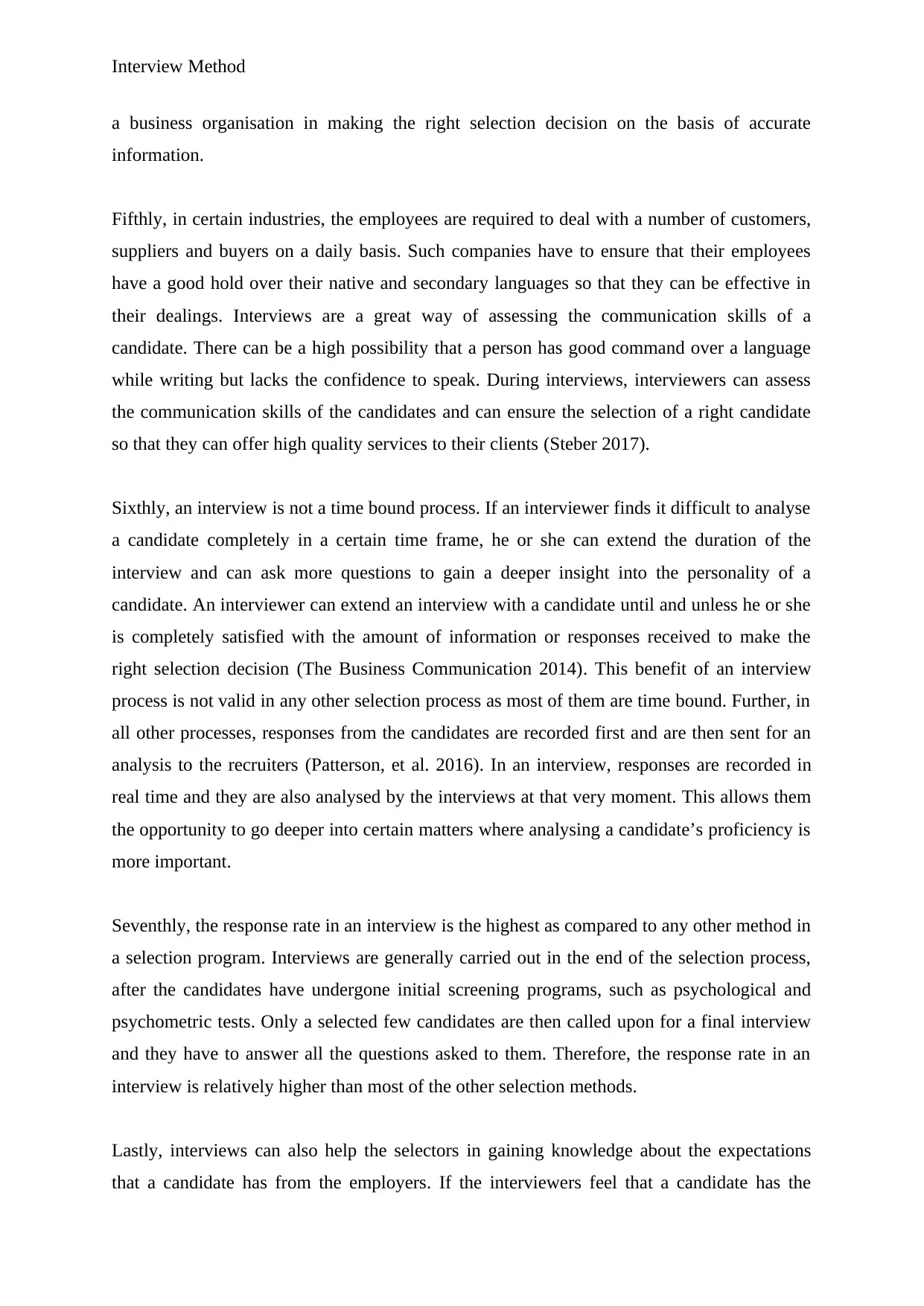
Interview Method
a business organisation in making the right selection decision on the basis of accurate
information.
Fifthly, in certain industries, the employees are required to deal with a number of customers,
suppliers and buyers on a daily basis. Such companies have to ensure that their employees
have a good hold over their native and secondary languages so that they can be effective in
their dealings. Interviews are a great way of assessing the communication skills of a
candidate. There can be a high possibility that a person has good command over a language
while writing but lacks the confidence to speak. During interviews, interviewers can assess
the communication skills of the candidates and can ensure the selection of a right candidate
so that they can offer high quality services to their clients (Steber 2017).
Sixthly, an interview is not a time bound process. If an interviewer finds it difficult to analyse
a candidate completely in a certain time frame, he or she can extend the duration of the
interview and can ask more questions to gain a deeper insight into the personality of a
candidate. An interviewer can extend an interview with a candidate until and unless he or she
is completely satisfied with the amount of information or responses received to make the
right selection decision (The Business Communication 2014). This benefit of an interview
process is not valid in any other selection process as most of them are time bound. Further, in
all other processes, responses from the candidates are recorded first and are then sent for an
analysis to the recruiters (Patterson, et al. 2016). In an interview, responses are recorded in
real time and they are also analysed by the interviews at that very moment. This allows them
the opportunity to go deeper into certain matters where analysing a candidate’s proficiency is
more important.
Seventhly, the response rate in an interview is the highest as compared to any other method in
a selection program. Interviews are generally carried out in the end of the selection process,
after the candidates have undergone initial screening programs, such as psychological and
psychometric tests. Only a selected few candidates are then called upon for a final interview
and they have to answer all the questions asked to them. Therefore, the response rate in an
interview is relatively higher than most of the other selection methods.
Lastly, interviews can also help the selectors in gaining knowledge about the expectations
that a candidate has from the employers. If the interviewers feel that a candidate has the
a business organisation in making the right selection decision on the basis of accurate
information.
Fifthly, in certain industries, the employees are required to deal with a number of customers,
suppliers and buyers on a daily basis. Such companies have to ensure that their employees
have a good hold over their native and secondary languages so that they can be effective in
their dealings. Interviews are a great way of assessing the communication skills of a
candidate. There can be a high possibility that a person has good command over a language
while writing but lacks the confidence to speak. During interviews, interviewers can assess
the communication skills of the candidates and can ensure the selection of a right candidate
so that they can offer high quality services to their clients (Steber 2017).
Sixthly, an interview is not a time bound process. If an interviewer finds it difficult to analyse
a candidate completely in a certain time frame, he or she can extend the duration of the
interview and can ask more questions to gain a deeper insight into the personality of a
candidate. An interviewer can extend an interview with a candidate until and unless he or she
is completely satisfied with the amount of information or responses received to make the
right selection decision (The Business Communication 2014). This benefit of an interview
process is not valid in any other selection process as most of them are time bound. Further, in
all other processes, responses from the candidates are recorded first and are then sent for an
analysis to the recruiters (Patterson, et al. 2016). In an interview, responses are recorded in
real time and they are also analysed by the interviews at that very moment. This allows them
the opportunity to go deeper into certain matters where analysing a candidate’s proficiency is
more important.
Seventhly, the response rate in an interview is the highest as compared to any other method in
a selection program. Interviews are generally carried out in the end of the selection process,
after the candidates have undergone initial screening programs, such as psychological and
psychometric tests. Only a selected few candidates are then called upon for a final interview
and they have to answer all the questions asked to them. Therefore, the response rate in an
interview is relatively higher than most of the other selection methods.
Lastly, interviews can also help the selectors in gaining knowledge about the expectations
that a candidate has from the employers. If the interviewers feel that a candidate has the
Paraphrase This Document
Need a fresh take? Get an instant paraphrase of this document with our AI Paraphraser
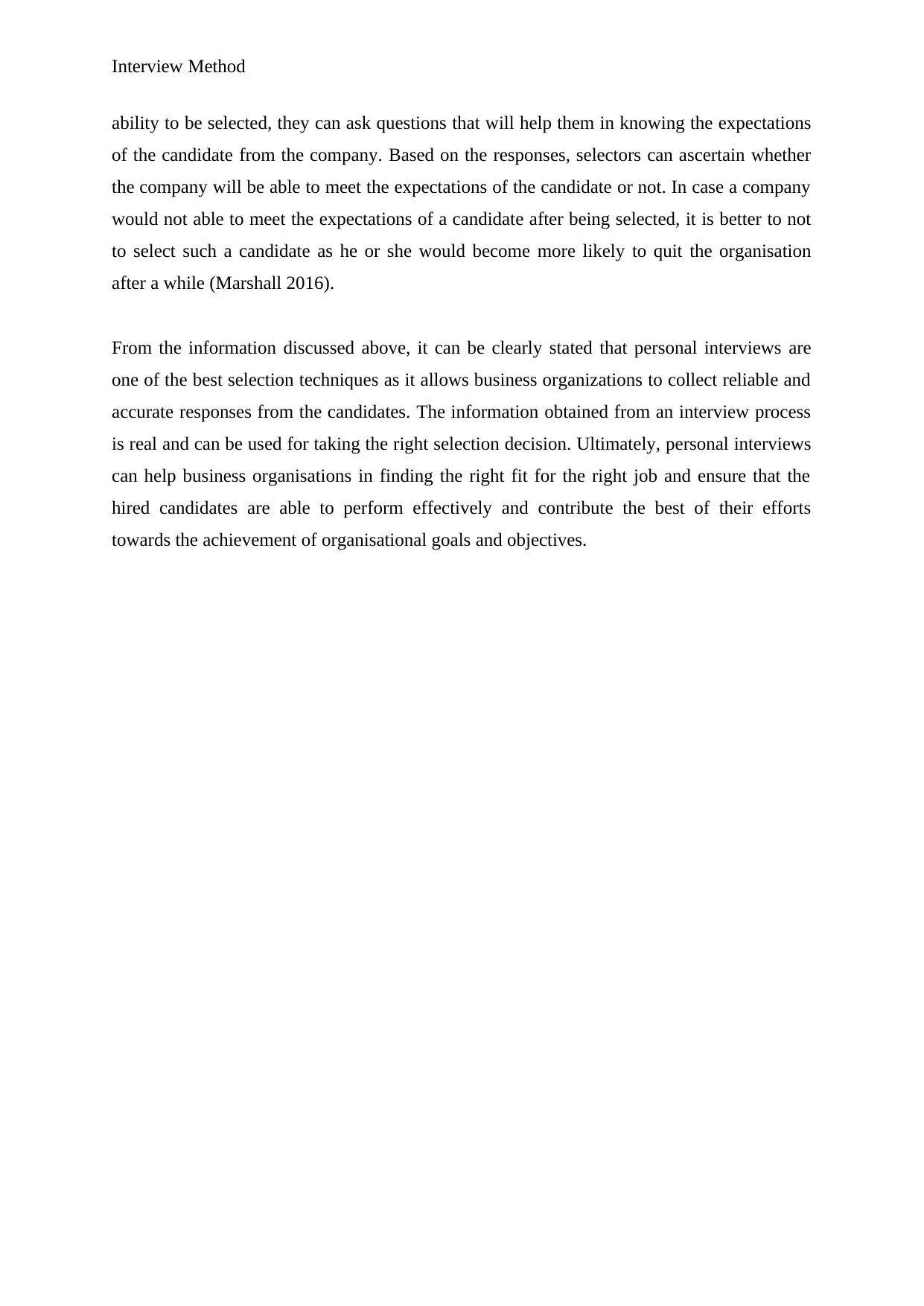
Interview Method
ability to be selected, they can ask questions that will help them in knowing the expectations
of the candidate from the company. Based on the responses, selectors can ascertain whether
the company will be able to meet the expectations of the candidate or not. In case a company
would not able to meet the expectations of a candidate after being selected, it is better to not
to select such a candidate as he or she would become more likely to quit the organisation
after a while (Marshall 2016).
From the information discussed above, it can be clearly stated that personal interviews are
one of the best selection techniques as it allows business organizations to collect reliable and
accurate responses from the candidates. The information obtained from an interview process
is real and can be used for taking the right selection decision. Ultimately, personal interviews
can help business organisations in finding the right fit for the right job and ensure that the
hired candidates are able to perform effectively and contribute the best of their efforts
towards the achievement of organisational goals and objectives.
ability to be selected, they can ask questions that will help them in knowing the expectations
of the candidate from the company. Based on the responses, selectors can ascertain whether
the company will be able to meet the expectations of the candidate or not. In case a company
would not able to meet the expectations of a candidate after being selected, it is better to not
to select such a candidate as he or she would become more likely to quit the organisation
after a while (Marshall 2016).
From the information discussed above, it can be clearly stated that personal interviews are
one of the best selection techniques as it allows business organizations to collect reliable and
accurate responses from the candidates. The information obtained from an interview process
is real and can be used for taking the right selection decision. Ultimately, personal interviews
can help business organisations in finding the right fit for the right job and ensure that the
hired candidates are able to perform effectively and contribute the best of their efforts
towards the achievement of organisational goals and objectives.
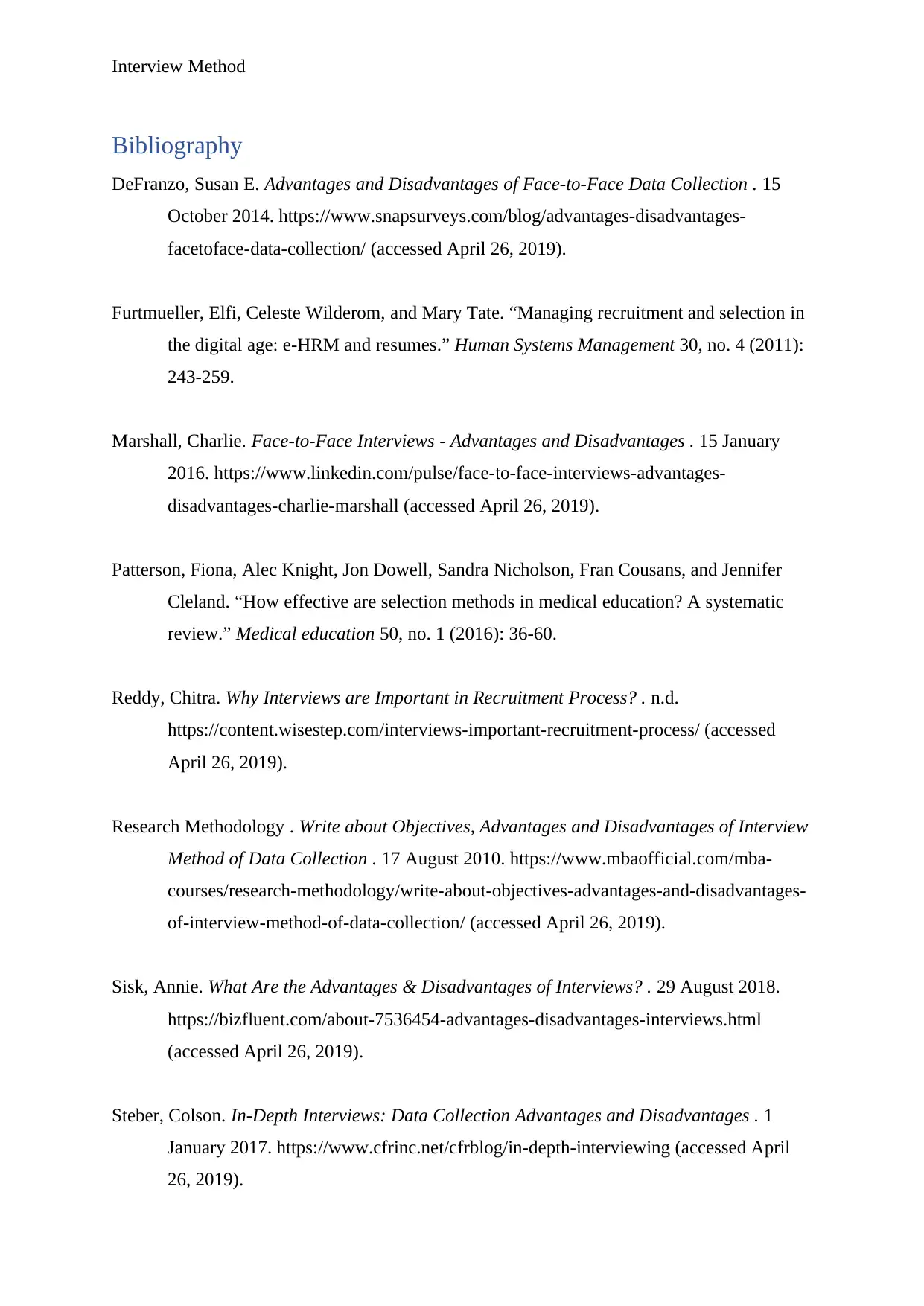
Interview Method
Bibliography
DeFranzo, Susan E. Advantages and Disadvantages of Face-to-Face Data Collection . 15
October 2014. https://www.snapsurveys.com/blog/advantages-disadvantages-
facetoface-data-collection/ (accessed April 26, 2019).
Furtmueller, Elfi, Celeste Wilderom, and Mary Tate. “Managing recruitment and selection in
the digital age: e-HRM and resumes.” Human Systems Management 30, no. 4 (2011):
243-259.
Marshall, Charlie. Face-to-Face Interviews - Advantages and Disadvantages . 15 January
2016. https://www.linkedin.com/pulse/face-to-face-interviews-advantages-
disadvantages-charlie-marshall (accessed April 26, 2019).
Patterson, Fiona, Alec Knight, Jon Dowell, Sandra Nicholson, Fran Cousans, and Jennifer
Cleland. “How effective are selection methods in medical education? A systematic
review.” Medical education 50, no. 1 (2016): 36-60.
Reddy, Chitra. Why Interviews are Important in Recruitment Process? . n.d.
https://content.wisestep.com/interviews-important-recruitment-process/ (accessed
April 26, 2019).
Research Methodology . Write about Objectives, Advantages and Disadvantages of Interview
Method of Data Collection . 17 August 2010. https://www.mbaofficial.com/mba-
courses/research-methodology/write-about-objectives-advantages-and-disadvantages-
of-interview-method-of-data-collection/ (accessed April 26, 2019).
Sisk, Annie. What Are the Advantages & Disadvantages of Interviews? . 29 August 2018.
https://bizfluent.com/about-7536454-advantages-disadvantages-interviews.html
(accessed April 26, 2019).
Steber, Colson. In-Depth Interviews: Data Collection Advantages and Disadvantages . 1
January 2017. https://www.cfrinc.net/cfrblog/in-depth-interviewing (accessed April
26, 2019).
Bibliography
DeFranzo, Susan E. Advantages and Disadvantages of Face-to-Face Data Collection . 15
October 2014. https://www.snapsurveys.com/blog/advantages-disadvantages-
facetoface-data-collection/ (accessed April 26, 2019).
Furtmueller, Elfi, Celeste Wilderom, and Mary Tate. “Managing recruitment and selection in
the digital age: e-HRM and resumes.” Human Systems Management 30, no. 4 (2011):
243-259.
Marshall, Charlie. Face-to-Face Interviews - Advantages and Disadvantages . 15 January
2016. https://www.linkedin.com/pulse/face-to-face-interviews-advantages-
disadvantages-charlie-marshall (accessed April 26, 2019).
Patterson, Fiona, Alec Knight, Jon Dowell, Sandra Nicholson, Fran Cousans, and Jennifer
Cleland. “How effective are selection methods in medical education? A systematic
review.” Medical education 50, no. 1 (2016): 36-60.
Reddy, Chitra. Why Interviews are Important in Recruitment Process? . n.d.
https://content.wisestep.com/interviews-important-recruitment-process/ (accessed
April 26, 2019).
Research Methodology . Write about Objectives, Advantages and Disadvantages of Interview
Method of Data Collection . 17 August 2010. https://www.mbaofficial.com/mba-
courses/research-methodology/write-about-objectives-advantages-and-disadvantages-
of-interview-method-of-data-collection/ (accessed April 26, 2019).
Sisk, Annie. What Are the Advantages & Disadvantages of Interviews? . 29 August 2018.
https://bizfluent.com/about-7536454-advantages-disadvantages-interviews.html
(accessed April 26, 2019).
Steber, Colson. In-Depth Interviews: Data Collection Advantages and Disadvantages . 1
January 2017. https://www.cfrinc.net/cfrblog/in-depth-interviewing (accessed April
26, 2019).
⊘ This is a preview!⊘
Do you want full access?
Subscribe today to unlock all pages.

Trusted by 1+ million students worldwide
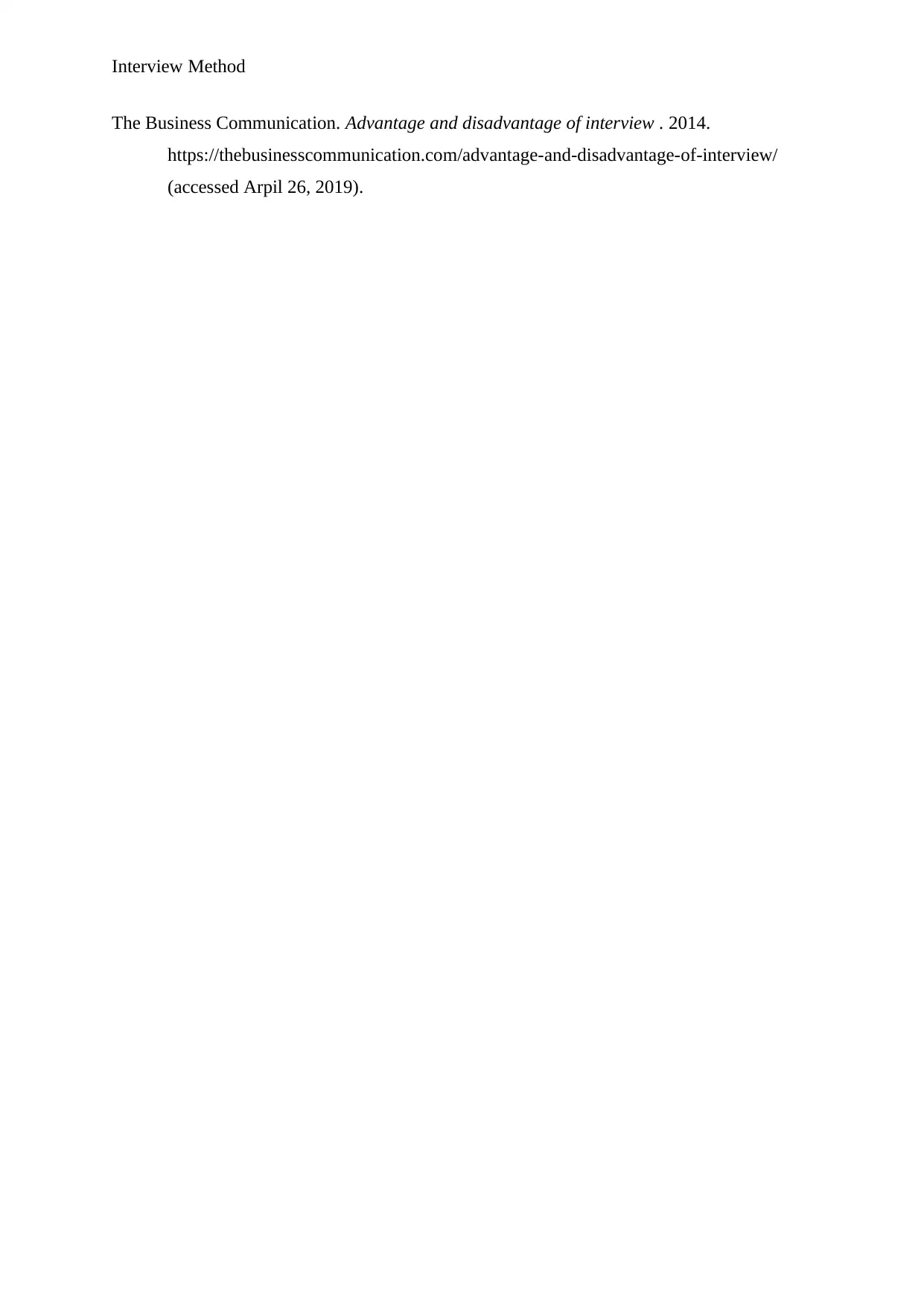
Interview Method
The Business Communication. Advantage and disadvantage of interview . 2014.
https://thebusinesscommunication.com/advantage-and-disadvantage-of-interview/
(accessed Arpil 26, 2019).
The Business Communication. Advantage and disadvantage of interview . 2014.
https://thebusinesscommunication.com/advantage-and-disadvantage-of-interview/
(accessed Arpil 26, 2019).
1 out of 7
Related Documents
Your All-in-One AI-Powered Toolkit for Academic Success.
+13062052269
info@desklib.com
Available 24*7 on WhatsApp / Email
![[object Object]](/_next/static/media/star-bottom.7253800d.svg)
Unlock your academic potential
Copyright © 2020–2025 A2Z Services. All Rights Reserved. Developed and managed by ZUCOL.





